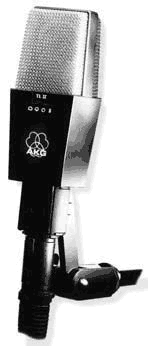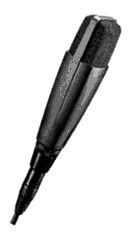Chris Speda <speda[at]stuttgart. netsurf.de>: For years I worked with the Neumann TLM 170. Great mic. A couple of months ago I checked the Brauner VM1. Brauner is a German guy who built this mic on his own (he told me). I really couldn’t believe what I heard. Very transparent and absolutely crisp. In comparison to the TLM 170, there are “worlds” between them. Imagine using a mic with a thick curtain in front of it. That’s my impression of the TLM 170 compared to the Brauner VM1. It’s not just a little; you will really hear it. By the way. The VM1 in Germany costs about 5000 DM. (That’s about $2,800). I didn’t buy it because I get 90% of my voices via online transmission with the MusicTaxi or APT-X. To me it makes no sense to spend this money. Another really good mic is the Sennheiser MD 321 (legendary). It makes male voices really huge. I often use the MD 321 instead the TLM 170. Getting a good voice sound to me is not done by getting the mic that costs the most money. It’s the way the talent works with it. If he can’t kiss the voice screen, he’s too far from a good sound.
Ty Ford <tford[at]jagunet.com>: TLM 103. It’s very loud (has a high output). It’s very quiet (has low self noise). Whereas most good condensers let you hear the bearings in the cart machines, the TLM 103 allows you to measure the viscosity of the oil on the bearings in the cart machines.
Jay Andrews, <jayandrewsproductions [at]juno.com>: My preferred studio microphone is, believe it or not, a Western Electric 639B ribbon-type. Reasons: 1) it has lots of range and is the only mike I’ve ever used that truly captures my whole voice. 2) no added EQ or compression needed while recording. I mean NONE. This mike has a very balanced tone that’s incredibly rich and full. 3) the mike sounds very different in each of its modes, making it extremely useful for endless vocal effects. Second favorite? My good old Sennheiser 421; it just won’t break and sounds great.
 J.P. Shane, <JPSHANEO[at]aol.com>: What mic is my favorite for VO? Good question. I put some true thought to it and have come to realize that “I’m one clingy-ass, obsessive, overprotective microphone OWNER! …There are three microphone’s I own that I use all the time and couldn’t live without. The old AKG C414 is one of the only microphones I know of that truly offers the level of versatility it brings to the table. I also own a U87—also great at several ends of the room. The mic I use for my voice is a Sennheiser MKH 416 P48. It’s not a great mic for females, nor is it very adjustable for the untrained voice. But if your voice is at all in the weeds, and your mic processor’s release time is fast enough to bounce back from some guy sucking up on a shotgun mic (like the Valley 401), it’s a combo that a ton of voice-over guys have been with for a long time. I like the sound I get from that setup.
J.P. Shane, <JPSHANEO[at]aol.com>: What mic is my favorite for VO? Good question. I put some true thought to it and have come to realize that “I’m one clingy-ass, obsessive, overprotective microphone OWNER! …There are three microphone’s I own that I use all the time and couldn’t live without. The old AKG C414 is one of the only microphones I know of that truly offers the level of versatility it brings to the table. I also own a U87—also great at several ends of the room. The mic I use for my voice is a Sennheiser MKH 416 P48. It’s not a great mic for females, nor is it very adjustable for the untrained voice. But if your voice is at all in the weeds, and your mic processor’s release time is fast enough to bounce back from some guy sucking up on a shotgun mic (like the Valley 401), it’s a combo that a ton of voice-over guys have been with for a long time. I like the sound I get from that setup.
 Craig Rogers, WHO/KMXD/KYSY, Des Moines, Iowa, <crogers [at]jacor.com>: I used to use a Sennheiser MD421 on the “M” setting because I liked the crispness it provided. I’m not a “big voice,” so I wanted to emphasize the midrange where my voice lies. I also liked the preset roll-offs, which made it easy to dial in a quick thin sound if needed. I switched to the ElectroVoice RE27 when our engineer brought one back from NAB a few years ago. Still had that crispness, but also brought out the lower resonance I do have without making things muddy. It also has several roll-off/boost options which I like.
Craig Rogers, WHO/KMXD/KYSY, Des Moines, Iowa, <crogers [at]jacor.com>: I used to use a Sennheiser MD421 on the “M” setting because I liked the crispness it provided. I’m not a “big voice,” so I wanted to emphasize the midrange where my voice lies. I also liked the preset roll-offs, which made it easy to dial in a quick thin sound if needed. I switched to the ElectroVoice RE27 when our engineer brought one back from NAB a few years ago. Still had that crispness, but also brought out the lower resonance I do have without making things muddy. It also has several roll-off/boost options which I like.
Johnny George, Johnny George Voiceovers, Indianapolis, Indiana, <HOTAUDIO[at]aol.com>: In my HotSpots! Studio I use the AKG 414B (retails at about $1000+, depending on who ya know). It’s normalled thru my Aphex Expressor 651. Settings to give it that upper mid-ranged kick, that I prefer, include the following: threshold -10, ratio 5, attack 10 ms, release time .06 sec, HFX ratio 7, frequency 6.4 kHz. The final inline signal I have routed through my Alesis dual 1/3 octave EQ with a little bottom kick at 80, mid boost at 2K and a little bite at 8K without having to worry about a de-esser. I’ve been very happy with this mic for the past 6 years and also use a CAD Equitek E-100 as my utility microphone. (That’s their basic mic that will run you about $500. Prices may vary. See dealer for details. Member FDIC.)
Mike Carta <kcarta[at]supersweep ers.com>: I use the Neumann TLM-193 mic. It’s very responsive and sounds great! I had been using an AKG-3000 condenser which I thought sounded pretty good until I plugged in the Neumann. I’m very pleased with the TLM-193.
Tim Mikkels <gunnpro[at]earthlink .net>: For a straightforward, honest, and true sound, the EV RE20 can’t be beat. I use the RE20 most of the time. I like it because it’s clear, crisp, and in my opinion, best duplicates the natural sounding voice.
Dennis Coleman, Infinity Broadcasting - Austin, <denman[at]swbell.net>: We use two Rode NT2 mics in our main studio, but Electro Voice stuff in the other rooms. I like the Rodes because they give us the warmth of the Neumanns for a fraction of the cost. The jocks took a while to get used to them though, since you don’t have to get right up on one to make it sound great.
Andy Capp, Impact Audio Creations, <andycap[at]dtgnet.com>: Ahh, one of those gear-head questions that I have a seriously biased opinion about! The experience that brought me the closest to complete audio nirvana was a voice-over session I did in a studio equipped with a Neumann U87, fed through a Focusrite Red pre. My God, I almost sounded like a real voice-over performer! Actually, I’m convinced that in the right hands, that combination could record the raunchiest bodily function and make it come out as a Mozart symphony.
I do believe that mics are indeed a matter of the voice being recorded. I’ve heard some incredible VOs done over a Shure SM-57, which costs a few coins less than the shock mount for a Neumann. The trick is finding “your” mic, and that means experimentation. Despite what many radio engineers may think, there is no Mythical Swiss Army Mic that can be all things to all voices.
Just as important is the choice of a mic pre-amp. I’ve heard the tone of some wonderful mics destroyed by the wrong pre, whether it was a cheap piece of garbage, or simply set up improperly. I cannot stress it enough: getting the “right sound” means experimenting with many mics and pre-amps, in different combinations. You’ll drive your dealer nuts, but it’s your voice-over quality that you are investing in.
